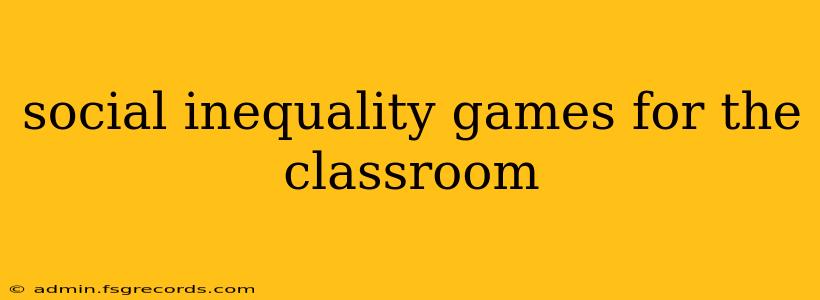Social inequality is a complex issue, and engaging students effectively requires creative approaches. Games provide a powerful tool to foster empathy, critical thinking, and a deeper understanding of systemic inequities without resorting to overly didactic methods. This post explores several game ideas suitable for various age groups and learning objectives, emphasizing experiential learning and fostering discussion.
Why Use Games to Teach About Social Inequality?
Traditional lectures and readings, while necessary, can sometimes fail to fully engage students with the emotional and experiential aspects of social inequality. Games offer a unique advantage:
- Increased Engagement: Gamified learning makes the subject more interactive and fun, keeping students actively involved.
- Experiential Learning: Games allow students to experience inequality, rather than just learning about it theoretically. This promotes deeper understanding and emotional connection.
- Safe Space for Exploration: The game environment provides a safe space to explore sensitive topics and grapple with difficult concepts without fear of judgment.
- Development of Critical Thinking: Many games require strategic decision-making, prompting students to analyze the impact of their choices and consider different perspectives.
Game Ideas for Different Age Groups and Learning Objectives
The following games can be adapted to fit specific classroom needs and age ranges. Remember to facilitate post-game discussions to maximize learning outcomes.
1. The "Resource Allocation" Game (Elementary & Middle School)
Objective: To demonstrate how unequal resource distribution can lead to social stratification.
Materials: Colored counters (representing different resources like food, housing, education), dice, game board with different "neighborhoods" (representing varying levels of privilege).
Gameplay: Students are assigned different roles (e.g., high-income, low-income) based on randomly assigned starting resources. They roll dice to earn more resources, but the game is designed so that some "neighborhoods" inherently have better access to resources. The game highlights the cumulative effects of unequal opportunities.
Post-Game Discussion: Focus on how starting resources influenced outcomes, the challenges faced by students with fewer resources, and the systemic factors that contributed to the inequality.
2. The "Privilege Walk" (Middle & High School)
Objective: To raise awareness of various privileges and how they intersect to create unequal experiences.
Materials: None (except possibly a space to walk).
Gameplay: The instructor reads out statements related to different aspects of privilege (e.g., race, gender, socioeconomic status, able-bodiedness). Students take a step forward if the statement applies to them and a step backward if it doesn't. The resulting visual representation powerfully illustrates the uneven distribution of privileges.
Post-Game Discussion: Discuss the significance of accumulated privileges, the invisibility of privilege for those who possess it, and the impact of intersecting identities.
3. "Simulation Game: A Day in the Life" (High School)
Objective: To simulate the daily challenges faced by individuals from different socioeconomic backgrounds.
Materials: Role cards describing different individuals' backgrounds (e.g., a single mother working multiple minimum-wage jobs, a wealthy executive, a homeless person).
Gameplay: Students are assigned roles and given specific tasks to complete within a set time frame (representing a day). The tasks and resources available vary based on the assigned role, creating vastly different experiences.
Post-Game Discussion: Students share their experiences, highlighting the disparities faced by individuals from different backgrounds and the systemic barriers they encountered.
4. "Policy Debate Game" (High School)
Objective: To analyze potential solutions to social inequality and engage in constructive debate.
Materials: Research materials on social policies related to inequality (e.g., welfare programs, affordable housing initiatives, education reform).
Gameplay: Students are divided into groups representing different viewpoints on specific policies. They research, prepare arguments, and engage in a structured debate, presenting their findings and defending their positions.
Post-Game Discussion: Analyze the strengths and weaknesses of different policy proposals, considering their potential impact on social equity.
Important Considerations
- Sensitivity and Inclusivity: Be mindful of the sensitive nature of the topic and create a safe and inclusive classroom environment.
- Facilitation: Effective facilitation is crucial for maximizing the learning potential of these games.
- Debriefing: The post-game discussion is just as important as the game itself. It's where students process their experiences and connect them to real-world issues.
By using these games strategically, educators can create engaging and impactful learning experiences that foster empathy, critical thinking, and a deeper understanding of social inequality. Remember to adapt these suggestions to your specific classroom context and student needs.

